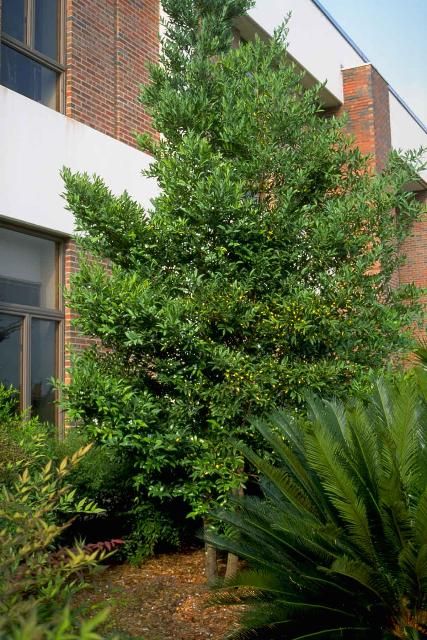Introduction
This upright, dense evergreen has pointed, leathery, dark green leaves arranged on stiff, symmetrical branches and works very well as a screen, hedge, strong accent plant, or framing tree. The crown forms a somewhat pyramidal to oval outline. Able to reach 90 feet in height, Nagi Podocarpus is usually seen at 30 to 40 feet in height due to the moderately-slow growth rate. Compact branching habit and very dark green foliage make this a dense tree in full sun, more open but surprisingly dense in shade.

Credit: Ed Gilman
General Information
Scientific name: Podocarpus nagi
Pronunciation: poe-doe-KAR-pus NAY-jye
Common name(s): Nagi Podocarpus, Broadleaf Podocarpus
Family: Podocarpaceae
USDA hardiness zones: 9A through 11 (Fig. 2)
Origin: not native to North America
Invasive potential :has been evaluated using the IFAS Assessment of the Status of Non-Native Plants in Florida's Natural Areas (UF/IFAS 2018). This species is not documented in any undisturbed natural areas in Florida. Thus, it is not considered a problem species and may be used in Florida.
Uses: indoors; screen; specimen; street without sidewalk; shade; hedge; parking lot island < 100 sq ft; parking lot island 100-200 sq ft; parking lot island > 200 sq ft; sidewalk cutout (tree pit); tree lawn 4-6 feet wide; tree lawn > 6 ft wide; urban tolerant; highway median
Availability: somewhat available, may have to go out of the region to find the tree

Description
Height: 30 to 50 feet
Spread: 15 to 25 feet
Crown uniformity: symmetrical
Crown shape: upright/erect, oval, pyramidal
Crown density: dense
Growth rate: moderate
Texture: medium
Foliage
Leaf arrangement: opposite/subopposite (Fig. 3)
Leaf type: simple
Leaf margin: entire
Leaf shape: elliptic (oval), ovate
Leaf venation: parallel
Leaf type and persistence: evergreen
Leaf blade length: less than 2 inches, 2 to 4 inches
Leaf color: green
Fall color: no color change
Fall characteristic: not showy

Flower
Flower color: yellow
Flower characteristics: not showy
Fruit
Fruit shape: round
Fruit length: .5 to 1 inch
Fruit covering: fleshy
Fruit color: purple
Fruit characteristics: does not attract wildlife; not showy; fruit/leaves not a litter problem
Trunk and Branches
Trunk/bark/branches: branches droop; not showy; typically one trunk; thorns
Pruning requirement: little required
Breakage: resistant
Current year twig color: green
Current year twig thickness: medium
Wood specific gravity: unknown
Culture
Light requirement: full sun, partial sun or partial shade, shade tolerant
Soil tolerances: clay; sand; loam; acidic; alkaline; well-drained
Drought tolerance: high
Aerosol salt tolerance: moderate
Other
Roots: not a problem
Winter interest: no
Outstanding tree: no
Ozone sensitivity: unknown
Verticillium wilt susceptibility: unknown
Pest resistance: resistant to pests/diseases
Use and Management
Growing well in full sun, partial or deep shade, Nagi Podocarpus tolerates a wide range of well-drained soils. In Florida, established trees grow well with no irrigation. Plants will show nutrient deficiencies on alkaline soils. The typical symptom is a wide yellow band or stripe across the leaves, usually attributed to magnesium deficiency. This is a tough tree, adaptable to urban conditions. It should be used more in areas with poor soils and restricted rooting space. With some pruning to create a more open canopy with well spaced ascending branches along the trunk, Nagi Podocarpus could make a good street tree. Eliminate branches with narrow angles of attachment in favor of those with a wider angle.
Propagation is by seeds or cuttings.
Pests
Scale and sooty mold can be found on Nagi podocarpus but this is usually not serious.
Diseases
It is susceptible to root rot on soils with poor drainage.
Literature Cited
University of Florida, Institute of Food and Agricultural Sciences. 2018. "Assessment of Non-native Plants in Florida's Natural Areas" (https://assessment.ifas.ufl.edu, 4/29/2019) Gainesville, FL, 32611-4000, USA.